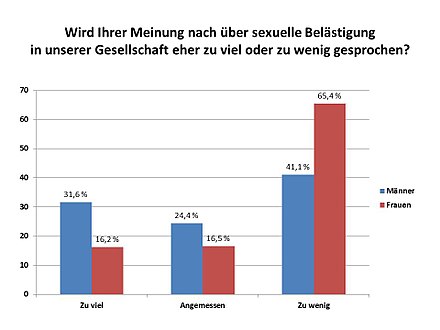Sexual harassment
![]()
This article or section is still missing the following important information:
Sexual harassment as a social phenomenon independent of the legal situation or an employment relationship
Help Wikipedia by researching and adding them.
Sexual harassment is a criminal offence and, among other things, a means of exercising power, in which power imbalances or relationships of dependency are unilaterally sexualised and thus perpetuated.
In terms of content, sexual harassment is concrete, sexually specific behaviour that is unwanted and that makes a person feel uncomfortable and violates their dignity. Sexual harassment includes, among other things, sexualizing remarks and actions that have a degrading or humiliating effect, unwanted physical advances, advances in connection with promises of rewards and/or threats of repression. Men and women in Germany largely agree on the distinction between appropriate erotic advances (flirting) and sexual harassment.
Sexual harassment belongs to the "broad range of individual phenomena" that are grouped together under the "umbrella term" of sexism. In everyday language, the terms "sexual harassment" and "sexism" are often mistakenly used as synonymous.
Women (28-58% depending on the survey) are much more likely to be victims of sexual harassment than men (around 10%). Regardless of the gender of the victim, the perpetrators are usually individual men, groups of men, mixed-gender groups and only rarely women. In public debate, on the other hand, the effect of perpetrator-victim reversal often gives rise to the image that men and women are equally victims and perpetrators.
Sexual harassment is considered discrimination in most Western countries and is illegal under employment law, among other things. It must be distinguished from sexual abuse and physical violence, which are criminal offences in their own right.

Survey on the topic of sexual harassment in Germany by gender
Occurrence
Sexual harassment can occur in all situations. It is critically assessed in relationships of dependency, such as in the workplace, in education or in the context of a medical care relationship.
Sexual assault in the workplace
A survey conducted in Switzerland in 2007 found that 28 per cent of the women and 10 per cent of the men interviewed had felt sexually harassed or disturbed by such behaviour in the course of their working lives to date. Harassing situations for women emanated from men (mostly from individual men, sometimes from groups of men) in three-quarters of cases. Women had also frequently reported harassing behaviour from mixed groups (men and women) and rarely reported harassing behaviour from women. Men reported that about half of the harassing situations came from men (individually or in groups), about a quarter from women and another quarter from mixed groups. First and foremost, it was colleagues at work who behaved in a harassing manner. In many cases it was also customers. In third place were superiors. Women reported harassing behaviour by superiors much more frequently than men. Men, on the other hand, referred more often than women to harassing behaviour by subordinates.
According to a study carried out for the European Commission, around 40-50% of female workers and around 10% of male workers have been the target of sexual harassment.
Still unexplored and very little anchored in social discourse is the sexual harassment of freelance men and women by clients or investors. In the absence of a workplace defined by labour law and the associated possibilities for protection, the offences against freelancers ultimately caused systematic discrimination of the victims up to and including complete exclusion from the group of contractors; this was the conclusion of the American lawyer and journalist Wendy Kaminer. In 2017, a large group of female start-up entrepreneurs from Silicon Valley reported sexual harassment by investors in the New York Times.
Sexual assault in schools and sports
Sexual assaults (sexual harassment, sexual violence or sexual abuse of children and young people) can occur in schools and sports clubs. The term sexual harassment may be broadly defined. For example, supplementary guidelines for schools in the municipality of Bremen from 2013 classify not only acts defined in accordance with section 3 (4) AGG, but also other acts as sexual harassment.
The Swiss Olympic Association distinguishes between explicit forms, which constitute punishable acts, and subtle forms of sexual assault and sexual harassment. The latter include the following acts: commenting on physical development, inappropriate sex education, voyeurism, sexist derogatory language, sexual advances, unnecessary physical contact and suggestive looks and remarks.
Sexual harassment in the medical care relationship
According to Swiss estimates, about 10 percent of male doctors commit sexual harassment. For female doctors, the percentage is much lower. All medical specialties are affected. The proportion of perpetrators is particularly high among psychiatrists, gynaecologists and general practitioners, at 15 per cent. 80 percent of the perpetrators are repeat offenders.
See also: Abuse of power in psychotherapy
Sexual assault in public spaces
In the wake of the massive sexual assaults on New Year's Eve 2015/16, the phenomenon of harassment in public spaces became the focus of discussions in the media and politics in German-speaking countries. As a subject of scholarship, the topic was largely unexplored in Germany until now, and there were also relatively few cases in the criminal statistics. As a result of the sudden awareness of the problem, legal experts pointed out existing gaps in the law and possible approaches to reform.

Johann Michael Neder, In the inn, 1833, Germanic National Museum in Nuremberg
See also
- Femme de la rue
Search within the encyclopedia